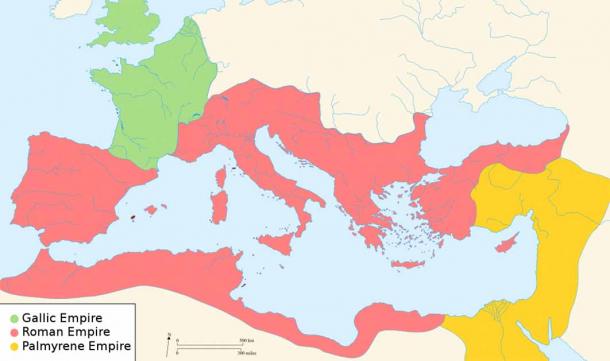
Third-Century Roman Empire: Revival From Chaos 270 – 285 BC
During the period designated by modern historians as the era of Roman military anarchy which lasted from 235 to 285 AD, 20 generals unconventionally elected as emperors fought and succeeded each other in rapid succession. To add to the confusion, an equivalent number of pretenders also took arms in attempting to grasp the purple cloak. By 270, the Roman world which had been confronted with the tribulations of these troubled times for more than three and a half decades, was facing obliteration. Besides the Empire having lost about half of its territory, Barbarian incursions were constant, and the provinces were devastated. The weakened and divided military, which had become very influential on the political scene, was still making and defeating emperors at its whim. The army leaders seemed to be more concerned with their own well-being than that of the Empire they were supposed to protect.

Map of the Roman Empire around the year of the consulship of Aurelianus and Bassus (271 AD), with the breakaway Gallic Empire in the West and the Palmyrene Empire in the East. (CC BY-SA 3.0)
During this turbulent period, the balance of the imperial finances became elusive. A gradual devaluation affected the Roman currency, and inflation was on the rise. Many emperors had the goodwill and capabilities to reign, but the missing ingredients were stability and time. Not surprisingly, the general context of a permanent crisis and the limited availability of resources made the task of the holder of the purple cloak extremely laborious and perilous. The condition of the peasants deteriorated considerably during that time as they remained the victims of frequent passages of armies and of overwhelming taxes. The Senate, whose active role on the political scene had been greatly diminished since the time of the Antonine Emperors, was now only a representative and barely consultative body.
Aurelian (270-275)
The son of a peasant from Illyria, Aurelian was a poorly educated, severe and rude career soldier, but he was energetic, strong, honest, and endowed with natural intelligence. In 242, under Emperor Gordian III, he distinguished himself as a tribune at the head of an auxiliary cohort during the campaign against the Sarmatians. In 253, with Emperor Gallienus, he stood out during the campaigns against the Germanic invaders. Aurelian, who was to become one of the great emperors of the century, was undoubtedly among the conspirators responsible for the assassination of Gallienus in Milan in 268, which led to the elevation of Emperor Claudius Gothicus.
Like this Preview and want to read on? You can! JOIN US THERE ( with easy, instant access ) and see what you’re missing!! All Premium articles are available in full, with immediate access.
For the price of a cup of coffee, you get this and all the other great benefits at Ancient Origins Premium. And - each time you support AO Premium, you support independent thought and writing.
Mario Bartolini has a master’s degree in political history from the Université de Sherbrooke, Canada, and a second master’s degree in war studies, obtained at the Royal Military College of Canada. He is the author of Roman Emperors: A Guide to the Men Who Ruled the Empire
Top Image: Roman soldiers on the march and their general (vukkostic /Adobe Stock)
By: Mario Bartolini














